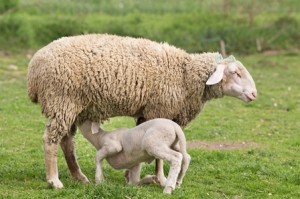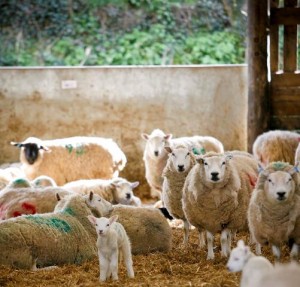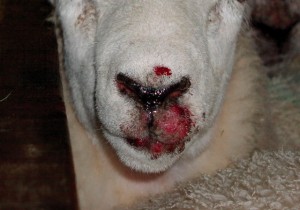Sheep Diseases
Orf Virus in Sheep
Also known as: Contagious Pustular Dermatitis, Contagious Ecthyma
Orf is a highly contagious eruptive skin condition of sheep and goats, but various other ruminants and mammals have been reported to be infected as well. It affects mainly young animals in the first year of their life and the more serious outbreaks are generally associated with intensive sheep husbandry. The virus is classified as a Poxvirus belonging to the genus Parapoxvirus. It is a pathogen with worldwide distribution, causing significant financial losses in livestock production. It is also a zoonotic disease, affecting mainly people who come in direct or indirect contact with infected animals, e.g. farmers, veterinarians and abattoir staff (Spyrou and Valiakos, 2015).
What is Orf?
The orf virus primarily affects the skin around the mouth, and under normal circumstances is resolved in 4 to 6 weeks. However, lesions may become extensive and spread to other parts of the body, and can be transmitted to the ewe’s udder causing her to refuse to suckle. The lesions on the udder may cause acute staphylococcal ewe mastitis and starvation of the lambs. Furthermore, the starving lambs may spread the disease to other ewes when trying to steal milk. Corneal infection and venereal infection with orf virus have also been described (Doherty et al., 1996; Reid, 1991). Strawberry foot rot may be a form of orf together with a bacterial infection (See sheep lameness).

Orf is a contagious virus that usually causes scabs and lesions in the mouth and gums of the infected animal. It mainly affects animals in the first year of their life, however, infected lambs can transmit the virus to the ewes udders whilst suckling.
Severely affected young lambs may be unable to eat for days, becoming debilitated and prone to secondary bacterial infection of the lesion which may lead to prolonged disease or even death (Gumbrell and McGregor, 1997). Production losses caused by the orf virus are believed to be underestimated, as it is not a notifiable disease (Spyrou and Valiakos, 2015).
Orf virus spreads through direct contact with infected animals or virus-contaminated fomites, and infection will only establish at sites where the skin is traumatised. Orphaned lambs are particular prone to the disease, possibly due to compromised immunity (Onyango et al., 2014), or transmission via feeding equipment. Biting insects may also be involved in the spread of the virus.
Infection spreads rapidly through the flock, with most animals becoming infected within a few weeks. Outbreaks can be particularly severe in housed sheep due to the high stocking rate. Contaminated livestock trailers may also be a source (Gumbrell and McGregor, 1997). Outbreaks usually last for between 6 and 8 weeks, and generally do not reappear until there is a fresh crop of susceptible lambs.
Survival of the virus between outbreaks is thought to be in the form of virus contained in scabs. It can survive under cool, dry circumstances for years. The virus has been found to survive for up to 17 years in environments with dry climate and remain viable on the wool of animals and contaminated material for significant periods (Spyrou and Valiakos, 2015), but has been found to lose its infectivity quickly in cold, wet circumstances (McKeever and Reid, 1986). An alternative source of infection may be the existence of chronic orf infections of sheep (McKeever, 1984; Nettleton et al., 1996a).
Sheep that have recovered from infection have only limited protection against reinfection, although subsequent infections tend to be milder and more short-lived than the initial one (McKeever et al., 1988). Antibodies are produced against the virus, but even when present in large amounts they seem to have little effect on the course of the disease (Greig et al., 1984; Yirrell et al., 1989).
Control and Prevention of Orf
Lower stocking rates and outdoor lambing may help to prevent serious outbreaks of orf because it is highly contagious and is transmitted readily from animal to animal. Disease can be introduced into a flock by carrier sheep with no obvious clinical signs, therefore a closed flock policy reduces the risk of the disease.

High stocking rates, and indoor lambing are considered to be risk factors for the spread of the orf virus. The virus can survive in dry cool areas for years so thorough cleaning and disinfection between batches is essential.
Live orf vaccines are available, which are prepared from infectious scab material (Nettleton et al., 1996b). These vaccines are applied by scarification and cause mild Orf lesions. However, protection is not lasting, although outbreaks that follow vaccination are milder and of short duration.
Vaccination can be useful in the face of an outbreak of the disease as a means of artificially infecting all animals and ensuring that they experience only mild disease. Vaccination of replacements bought into flocks already infected with orf may also be useful. As the scabs shed from vaccinal lesions contain live virus and contaminate the environment, vaccines should never be used unless there is a known problem with orf. Vaccinated ewes should not be allowed access to the lambing area until all scabs are shed (Reid, 1991).
If an orf outbreak occurs disinfection of buildings is essential. The building should be thoroughly cleaned before applying the disinfectant. Orf virus is susceptible to most disinfectants. Exposure to 3% iodophor solution or 1% formaldehyde will kill the virus, however iodophor disinfectants are expensive, and specific clothing and respirators are required when using formaldehyde. Hypochlorite solution is one of the disinfectants recommended by the World Organisation for Animal Health (OIE), however it is rapidly inactivated by the presence of organic matter so cleaning before disinfecting is required (Gallina and Scagliarini 2010). Particular attention should be paid to cleaning in and around pen divisions and feeding troughs.
Chronically infected sheep may act as a source of infection to susceptible animals and have to be removed from the flock (Greig et al., 1984; McKeever, 1984).
Treating Orf
At present there is no practical means of killing the virus once it is established in the animal, although there is some experimental evidence of a reduction in lesion severity with an antiviral drug (Scagliarini et al., 2008). However, orf is a self-limited disease and symptomatic treatment with dressings and local antiseptics are very helpful. Where secondary bacterial infections in animals with orf are common, topical and systemic antibiotics can be used in the treatment schedule (Nandi et al., 2011). In ewes with severe teat lesions, they can be treated with a local treatment of tetracycline (Burriel, 1997). Where possible, scabs that have been shed from lesions should be removed and incinerated.
Treatment of the scabby lesions with herbal remedies may help. Of these, plant oils obtained from sesame, castor, juice of Calotropis procera and Euphorbia spp. have been found to be effective in the treatment of orf infection in India and African subcontinents. Whereas in France and Netherlands, Ilex aquifolium is used for curing and preventing contagious ecthyma (Nandi et al., 2011).
Attention to feeding may prevent severe weight loss and debilitation in animals, especially in lambs having difficulty with sucking.
Orf and Welfare

Orf can affect sheep of all ages and has serious welfare implications. It causes scabs and lesions usually in the mouth area, but can affect udders and feet as well. There isn’t a cure to get rid of the virus once it has become established in the animal; however, the secondary infections can be treated. This image is sourced from www.msd-animal-health.co.uk.
Orf is characterised by the appearance of scabby lesions on the lips and nostrils. These may spread to the gums, palate and tongue, and severely affected lambs may be unable to feed for several days, becoming debilitated and prone to other diseases. The ewe’s udder may also become affected, causing her to refuse to suckle. This may have serious repercussions, resulting in mastitis in the ewe and starvation of the lamb.
Lesions on other body parts may become susceptible to secondary bacterial invasion, resulting in prolonged disease and even death. It is therefore important to try and prevent orf from occurring in the flock.
Good Practice Based on Current Knowledge
If there is a known problem with orf on the farm measures have to be taken to eliminate the disease from the flock as part of the overall flock health plan. These include:
- Reduce stocking rates and, if possible, lamb outdoors
- Buildings and equipment used for sheep have to be thoroughly disinfected
- Known or suspected chronically infected sheep have to be removed from the flock
Other recommendations include:
- Maintain a closed flock
- In the case of an outbreak, vaccinate the animals to reduce the severity of the disease
- Where possible, separate affected animals from the rest of the flock
- Never vaccinate against orf unless there is a known problem with the disease
- Make sure affected lambs are able to suck and eat, assistance may be required. Check for corneal and venereal orf
Recommended further reading: http://www.moredun.org.uk/research/practical-animal-health-information/disease-summaries/orf-virus-infection-sheep


 American English
American English

Comments are closed.